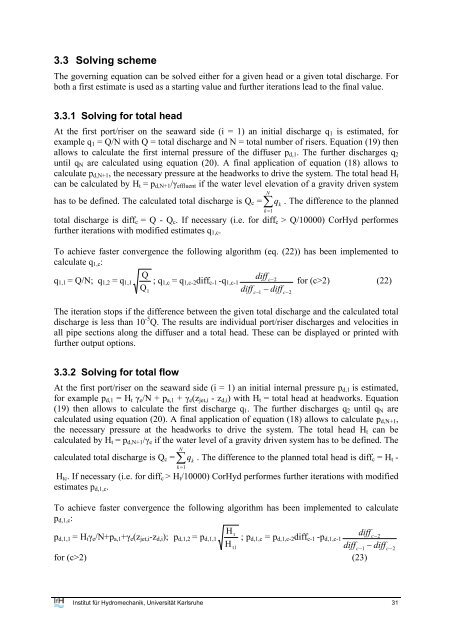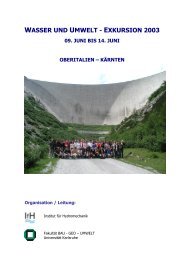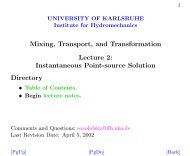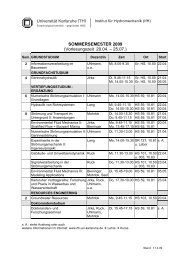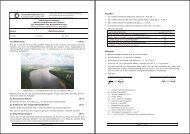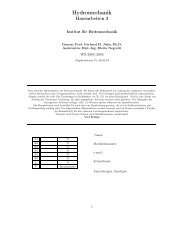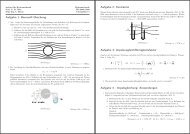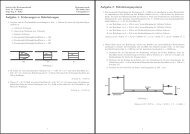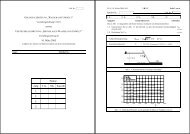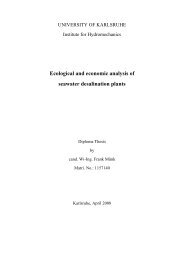user's manual for corhyd: an internal diffuser hydraulics model - IfH
user's manual for corhyd: an internal diffuser hydraulics model - IfH
user's manual for corhyd: an internal diffuser hydraulics model - IfH
Create successful ePaper yourself
Turn your PDF publications into a flip-book with our unique Google optimized e-Paper software.
3.3 Solving scheme<br />
The governing equation c<strong>an</strong> be solved either <strong>for</strong> a given head or a given total discharge. For<br />
both a first estimate is used as a starting value <strong>an</strong>d further iterations lead to the final value.<br />
3.3.1 Solving <strong>for</strong> total head<br />
At the first port/riser on the seaward side (i = 1) <strong>an</strong> initial discharge q 1 is estimated, <strong>for</strong><br />
example q 1 = Q/N with Q = total discharge <strong>an</strong>d N = total number of risers. Equation (19) then<br />
allows to calculate the first <strong>internal</strong> pressure of the <strong>diffuser</strong> p d,1 . The further discharges q 2<br />
until q N are calculated using equation (20). A final application of equation (18) allows to<br />
calculate p d,N+1 , the necessary pressure at the headworks to drive the system. The total head H t<br />
c<strong>an</strong> be calculated by H t = p d,N+1 /γ effluent if the water level elevation of a gravity driven system<br />
has to be defined. The calculated total discharge is Q c =∑<br />
N<br />
q k<br />
k = 1<br />
. The difference to the pl<strong>an</strong>ned<br />
total discharge is diffc = Q - Q c . If necessary (i.e. <strong>for</strong> diff c > Q/10000) CorHyd per<strong>for</strong>mes<br />
further iterations with modified estimates q 1,c .<br />
To achieve faster convergence the following algorithm (eq. (22)) has been implemented to<br />
calculate q 1,c :<br />
q 1,1 = Q/N; q 1,2 = q Q 1,1 ; Q<br />
q1,c = q 1,c-2 diff c-1 -q diff<br />
1,c-1 c−2<br />
<strong>for</strong> (c>2) (22)<br />
1<br />
diff<br />
1<br />
− diff<br />
2<br />
The iteration stops if the difference between the given total discharge <strong>an</strong>d the calculated total<br />
discharge is less th<strong>an</strong> 10 -5 Q. The results are individual port/riser discharges <strong>an</strong>d velocities in<br />
all pipe sections along the <strong>diffuser</strong> <strong>an</strong>d a total head. These c<strong>an</strong> be displayed or printed with<br />
further output options.<br />
c−<br />
c−<br />
3.3.2 Solving <strong>for</strong> total flow<br />
At the first port/riser on the seaward side (i = 1) <strong>an</strong> initial <strong>internal</strong> pressure p d,1 is estimated,<br />
<strong>for</strong> example p d,1 = H t γ e /N + p a,1 + γ e (z jet,i - z d,i ) with H t = total head at headworks. Equation<br />
(19) then allows to calculate the first discharge q 1 . The further discharges q 2 until q N are<br />
calculated using equation (20). A final application of equation (18) allows to calculate p d,N+1 ,<br />
the necessary pressure at the headworks to drive the system. The total head H t c<strong>an</strong> be<br />
calculated by H t = p d,N+1 /γ e if the water level of a gravity driven system has to be defined. The<br />
N<br />
q k<br />
k = 1<br />
calculated total discharge is Q c =∑<br />
. The difference to the pl<strong>an</strong>ned total head is diffc = H t -<br />
H tc . If necessary (i.e. <strong>for</strong> diff c > H t /10000) CorHyd per<strong>for</strong>mes further iterations with modified<br />
estimates p d,1,c .<br />
To achieve faster convergence the following algorithm has been implemented to calculate<br />
p d,1,c :<br />
p d,1,1 = H t γ e /N+p a,1 +γ e (z jet,i -z d,i ); p d,1,2 = p H t<br />
d,1,1 ; H<br />
pd,1,c = p d,1,c-2 diff c-1 -p diff<br />
d,1,c-1 c−2<br />
t1<br />
diffc−<br />
1<br />
− diffc−<br />
2<br />
<strong>for</strong> (c>2) (23)<br />
Institut für Hydromech<strong>an</strong>ik, Universität Karlsruhe 31


